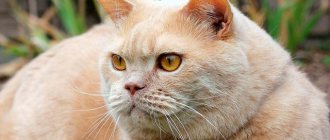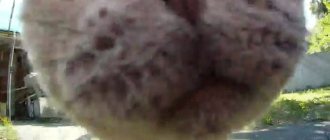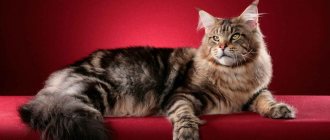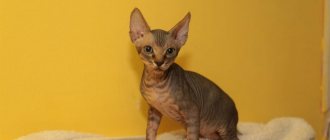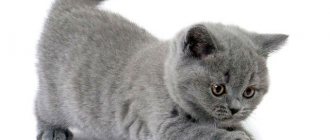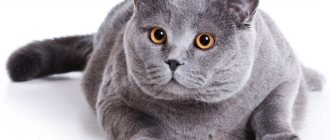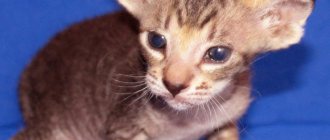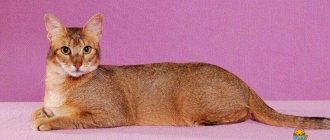Every person who has at least once been to exhibitions where British cats participated was surprised by the diversity of these animals.
And this is true, because the British have such a colossal range of palettes of their wool that some cannot count them. One of the colors that is included in this number is tabby.
Marble color
This color is that the color of the coat can be completely different, but there are patterns and certain elements on it.
Such elements may include:
- necklace (stripes around the neck);
- clear stripes around the tail and paws, slightly darker than the base color of the coat;
- richly colored hairs;
- on the forehead, a darker color than the main one, the letter “M” is clearly visible;
- the nose and eyes should be outlined with a clear outline of the color of the coat;
- the back wall of the ear has an imprint in a color slightly lighter than the main one.
According to established standards, the British tabby color can have only three types of pattern:
- marble (see photo of a marble Briton);
- spotted;
- brindle.
Brindle color
However, the interesting thing is that such basic elements can be present on a kitten of any color. They include: tortoiseshell, golden, smoky, silver, etc. Thanks to this diversity, the tabby color is impressive.
Let's look at these three main drawings in order.
Where does the British marbled cat come from?
Since the beginning of the 20th century.
British cats included not only plain blue animals, but also tabby cats with different shades on their fur coats. Thus, in 1901, American felinologists registered a Belle cat with a red tabby color. British marbled cats appeared as a result of crossing with other breeds
The consequence of two world wars was the almost complete extermination of the British breed, so breeders began to crossbreed pets with representatives of other varieties - Burmese, Russian Blues, Persians and Scottish. The result was the appearance of many varieties of British color while simultaneously preserving the breed characteristics (wide paws, protruding cheekbones, “plush” coat).
At the same time, among all the variations of the striped coat of the British fur coat, it is the marble color that is considered classic, occurring naturally. Zoologists are inclined to believe that the symmetrical darkening on the fur of catfish from Foggy Albion is an inheritance from wild Asian or African ancestors.
Description of the breed
The physiology and appearance of the British were formed under high humidity in cold climates, therefore this breed has dense short hair that protects from cold and moisture.
Since British cats are excellent hunters, they are strong, hardy and unpretentious in food.
The breed standard describes the British as follows:
- The head has a wide skull and is round. The cheeks are developed, the cheekbones are wide, the muzzle is flattened and round.
- The nose is wide, straight and short.
- The ears are rounded and small, set wide and low.
- The eyes are round, at a great distance from each other, which exceeds the width of the nose.
- The body is massive, with a developed chest and good muscles.
- The limbs are powerful, but short. Paws are rounded.
- The tail is thick.
- Weight - Males weigh 10-13 kg, and females from 6 to 9 kg.
Wool protects cats well from the cold due to the developed undercoat. It does not adhere to the body, is thick and plush to the touch.
Sometimes there are longhaired British cats. A recessive gene is responsible for long fur, so a long-haired kitten cannot appear from ordinary parents.
People often confuse British and Scottish cats: some even seriously think that there is such a breed - the British Fold. The two different breeds should not be confused.
BRITISH STRIPED COLOR (BRINCH, MACKERL)
The striped color of the British (British brindle tabby) must comply with all the same standards as the spotted one, only the pattern on the back and sides must have clear and uninterrupted stripes. In the color of a British Tabby Shorthair cat, the stripes should start at the spine and extend all the way to the paws. The stripes of a British brindle cat are narrow and frequent (and it is believed that the more often the better). Mackerel stripes (mackerel) should not intersect each other, be strictly vertical and always contrasting.
A brindle (striped) British kitten, even with very clear stripes, can “stretch” its color by adulthood and, if the stripes begin to be interrupted anywhere, the color is reviewed by experts and assigned - spotted. The full color of a British brindle kitten will be formed only by the age of one year (other tabby colors are not subject to such changes and most often do not change the appearance of the tabby pattern in adulthood).
British tabby cats are not as common as spotted cats, but more common than marbled cats.
The eye color of British tabby cats can be copper (golden, orange) or green (gold, occasionally silver).
Chocolate tabby British kitten: photo of California
Ideal British Shorthair eye color based on coat color
Speaking about the colors of the British Shorthair breed, it is worth mentioning the shade of the eyes in each category, as this is very important for the correct assessment of the animal.
Below is a table of the correspondence of the shade of the cornea of the British Shorthair's eyes to the fur color.
| Eye color | Wool shade |
| Orange, amber, gold | Black and blue. |
| Cinnamon (cinnamon) and fawn. | |
| Blue | Color-point colors. |
| Green, brown, orange, amber, gold | Silver tabby. |
| Green, blue, orange, colorful | White. Eye color is determined by the amount of pigment in the iris. If there is a lot of it, the cornea will have an orange tint, while in the complete absence it will have a blue tint. Green and yellow tones lie somewhere in the middle of these two extremes.
A dilution program that does not take eye color into account ultimately results in a dilution of the desired shade, with all corneal tones shifting toward the middle of the spectrum and ending up yellow or green. Look at the handsome blue-eyed Briton Kobe: British Blue eye colorBlue British Shorthairs have been bred widely and over a long period of time, so the characteristics of the British Blue color have a fantastic opportunity for development. The result is many blue British Shorthair cats with a fantastic orange eye tint, although this is a very difficult color to breed. Blue color with yellow eyes Shorthair British Chocolate LilacChocolate and lilac colors have recently been introduced in this ancient breed. Bicolor with base lilac and dark orange eyes As a result, it is much more difficult to find chocolate or lilac British Shorthairs with exceptional orange eye color: most "chocolate" and "lilac" have irises of yellow or amber shades. Although some breeders managed to get incredibly orange eyes from lilac shades of color. Cinnamon and fawn British Shorthair colorCinnamon and fawn coat colors have appeared more recently, and the eye color of these animals is similar to the shade of “chocolate” and “lilac”, but less developed and not as rich. Color Point British ShorthairFor breeders of English cats of this color, the goal is to have the eyes as blue as possible and this is a very difficult task. Color point kitten with blue eyes Most colorpoints have silver-blue eyes. They are incredibly beautiful in their own right, and many people actually prefer silver tones over bright blue.
Silver irises have very little pigment. Professional breeding and eye color of the British ShorthairUltimately the eye color that is preferred in an animal is a personal choice of the breeder and will obviously not affect the purity and beauty of the breed.
A good experienced breeder will be able to help the client choose their most suitable kitten. British Shorthair kitten - correct eye coloringAll British Shorthair kittens are born with blue eyes. Gradually, as they grow older, they acquire their true color. This transition begins when the cubs are about 6-8 weeks old and continues until they are about 2 years old, when they finally reach their full colors. For example, a blue British Shorthair kitten is born with blue eyes, and these will then change color to a variety of shades, including dirty brown and green, before the color is fully developed.
|
Types of drawings
Tabby is not one specific pattern, as many people believe. There are several varieties of it, and all are considered standard. The pattern appears due to the A gene (agutti). A British female with the color formula “AA” gives birth to only patterned kittens, and with “Aa” the ratio of patterned kittens to plain ones is 50%. Cats with the formula “aa” will be monochromatic.
There are four main types of tabby patterns: ticked, striped, marbled, spotted.
Ticked (Abyssinian)
At first glance, it may seem that the British ticked coat is a solid color, but this is not the case. The color of their coat is not at all uniform: the whole body has barely noticeable stripes, spots or specks (there are “freckles”), slightly darker than the main tone of the British. The tip of the tail is usually dark. Eyes are golden or green.
Striped, brindle (mackerel)
The British tabby cat is the most popular cat available. The second name appeared due to the similarity with the color of the mackerel fish. The pattern is characterized by frequent narrow, clear stripes throughout the body, especially along the ridge. British tabbys are characterized by necklace-like lines on the chest and a broken stripe on the forehead, reminiscent of the Russian letter “M”. The British cat's full brindle coloration develops by the age of one year.
Classic (marble)
One of the most favorite colors among breeders of this breed is the marbled tabby. It is visible already from the birth of the kitten, it may merge slightly, but by two months it has a clear pattern. The body is covered with wide ornate patterns with clear outlines on the back, sides and vague ones on the abdomen and paws. The color of the pattern contrasts with the main shade of the Briton’s body – a kind of marble on silver.
Spotted (leopard)
A cat of the British breed with this coloring is similar to a representative of the wild - a leopard, but in miniature. Wide stripes are intermittent and represent spots of various sizes. Eye color: copper, green.
Color standard
The variety of cat colors never ceases to amaze. But there are standard distinctive features that are required for tabby cats:
- an “M” sign appears on the forehead between the eyebrows;
- the eyes and nose are edged with a thin line, thanks to which they stand out on the muzzle;
- on the stomach - individual spots placed in rows;
- on the neck there are continuous stripes, similar to a necklace;
- paws and tail are covered with ring-shaped stripes;
- the contrasting pattern is clear and bright;
- pets with a silver tint of fur have green eyes;
- other tabby cats have warm-colored eyes (lemon, copper, orange, brown, amber).
With all these standard characteristics, it is impossible to find two cats with exactly the same pattern.
Originality, brightness, uniqueness and originality of color - these are the characteristics that are valued by knowledgeable lovers of tabby-colored pets.
Where did this color come from and why is it called that?
The question of where cats of such bizarre colors and different breeds come from will certainly arise if a British kitten appears in the house. The tabby color was most likely inherited by domestic cats from their wild ancestors, the Nubian Dun. It is from this species of cat that all our short-haired pets originated.
As for the term “tabby” itself, there are several versions about its origin. The most beautiful sounds like this. Somewhere at the beginning of the 17th century, silk fabrics, which were worth their weight in gold, were first brought to England. Their pattern was very similar to a cat's color and was called "tabbis". And when they later began to breed cats with a similar color, they were called tabby. In addition, cats of this color, like silk, were very expensive, since breeding them is extremely difficult - it is difficult to obtain the necessary pattern, shade and eye color that matches them.
British cat: care and maintenance
The British have a thick fur coat that needs to be combed out as a rule. Regularity greatly depends on the time of year: when the cat sheds (spring and autumn), you will have to comb it more often (up to 2-3 times a week). As for the rest, everything is the same as with other cats:
- washing in the bathroom no more than a couple of times a year (if necessary);
- combing with a special brush to remove loose hairs about once a week;
- checking (once a week) and cleaning the ears (if necessary);
- nail trimming (once every one to two weeks);
- checking and cleaning teeth (if necessary).
Aristocrats can fool around too.
Health
The British Shorthair cat is not susceptible to hereditary diseases. She is in excellent health. However, this does not mean that vaccination and preventive examinations by a veterinarian can be neglected.
It must be taken into account that sexual and physical maturation in general occurs late in the British - around the age of four. It is at this age that kittens turn into adult cats: they show all the solidity and massiveness provided for by the standards. There is no point in sounding the alarm or suspecting dystrophy until this moment.
In comfortable conditions, a Briton lives on average 15 years. However, there are record holders in the breed whose age has exceeded 20. The reasons are simple: lack of stress, active cat life, balanced food and, of course, unconditional love. The well-being of the British largely depends on feeling like a member of the family.
Marbled Tabby
The marble tabby color in cats is the most beautiful, bright and complex. In addition, it is also the rarest due to difficulties in crossing - two marbled individuals can produce a tabby or spotted kitten. Such British cats wear three parallel stripes on the back, and large closed circles on the sides, inside of which there are brightly colored spots. Such a pattern should not intersect or be interrupted. In addition, a Marbled Briton must have the following markings:
- A pattern on the back of the head and shoulders resembling a butterfly.
- Patterns on the cheeks that start from the very corners of the eyes.
- "M" pattern on the forehead.
- The neck and chest are decorated with necklaces - the more, the better.
- There are spots on the tummy.
- The paws and tail must be ringed.
- The circles on the hips must be closed.
The color is rejected if the pattern is not contrasting enough, or if it shows residual faded stripes.
In a British cat, the merle color can be identified from birth. However, final alignment and clear drawing occur by two months. Therefore, if you want to get a real British harlequin, wait until this time, and do not adopt a kitten earlier.
British cat: pregnancy and childbirth
Pregnancy in the British cat breed lasts on average 9 weeks.
Closer to the due date, the cat begins to look for a quiet and calm corner so that it can give birth. Labor in the British cat breed lasts from two to fourteen hours. Sleeping on your beloved mother is warm, soft, cozy and sweet .
The number of kittens depends on the age of the cat and whether this is the first birth or not:
- First birth: 1-3 kittens;
- Second and further: 2-5 kittens.
Required elements
The tabby color, despite many variations, has a number of unchanged elements:
- Ticking is actually the presence of the pattern itself. In this case, the hairs of the coat should be uniform in color down to the base.
- On the forehead of such cats there is always a pattern resembling the letter “M”, the so-called scarab sign.
- There should be a fingerprint-shaped spot on the back of the ear.
- The nose and eyes should be outlined. In this case, the color of the outline should be the same as the main color.
- The pattern, if there is one, must include the following elements: “necklace” - three closed stripes on the chest; “curls” on the cheeks; There are two rows of double spots on the tummy. All drawings should be clear and rich, and the coloring should be deep.
- There are also typical eye colors for tabbies - golden, orange and copper. If the color is silver, then the cat's eyes should be green.
If a Briton's color is blurred, and the patterns are cloudy and merge with the main color, then this is a defect. Most likely, one parent was a tabby and the other was a solid.
Ticked
Despite the fact that the ticked color belongs to the tabby cat colors, it has practically no pattern and looks like a solid color. The peculiarity is the brightness of the color of the main coat, and the upper part seems to be shaded. If you look closely, you will find that there are stripes on each hair. Of all the standard tabby color requirements, this color only has the letter "M" above the eyes and patterns on the face. If a ticked color has other main features of a tabby color, it will be rejected. This is a rather rare color subtype, because ticked males and females can produce kittens with any pattern on their coat.
BRI e 25 – cream ticked
BRI ny 25 – black gold ticked
Types of colors
Selection work on representatives of the British breed, involving various bloods, has led to a variety of both colors and breed types. If initially the British had short hair with a thick undercoat, then crossing with the Persian cat made it possible to obtain semi-long-haired animals. The colors of British longhair cats correspond to the colors of shorthair cats.
Many people only think of Britons as smoky, blue or tabby cats and don't even realize how many colors the breed has. Even a pair of quite ordinary parents can produce a kitten of a rare color.
To organize the variety of colors of British cats, they are divided into types and groups according to color, pattern and method of pigmentation.
Types of colors of British cats:
- solid (or plain);
- typed: smoky, veiled, shaded;
- gold;
- silver;
- tortoiseshells;
- color point;
- particolors: harlequin, bicolor, van, mitted;
- tabbies: spotted, striped, marbled, ticked.
A table of the colors of British cats will help you imagine all the diversity.
Breeding the British Shorthair cat
British cats are always bred only with British cats. Since 2006, mating between British and Scottish dogs has been officially banned. If you breed a fold-eared cat with a straight-eared cat, some of the offspring will die.
Color compatibility list:
- golden and silver chinchillas are bred only with golden and silver chinchillas;
- if you mix the black group of colors (black, blue, chocolate) and the red group of colors (cream, red, red), tortoiseshell kittens will be born;
- A striped cat (tabby) should also be bred with a tabby cat, but relaxations are allowed here.
The first mating is carried out when the animals are 1 year old. The compatibility of the blood group is taken into account; if it is negative, the pregnancy will be terminated in the first days. On average, a cat gives birth to 5-6 straight-eared kittens.
Important!
Before mating, it is necessary to check the health of each animal.
Possible tabby colors
Among tabby cats, gray and silver cats predominate with markings of a wide variety of colors: lilac, chocolate, blue, smoky black, reddish. But this does not mean that other tabby colors are rare. In the table below we look at the main variations of tabby color.
Table 2. Possible flower combinations for tabby color
| Color name | Marking color | Leading coat shade |
| Amber | Smoke black | Peach |
| Black silver | Deep black | Silver |
| Blue | Gray dust | Ivory |
| Blue silver | Grey | White |
| Bronze | Dark chocolate | Warm cream |
| Brown | Black night | Gray with brown or copper fade |
| Cameo | Fiery red | Warm ivory |
| Caramel | Milk chocolate with light color | Beige |
| Coal | Black chocolate | Smoke gray |
| Chestnut | Bright brown | Cream with possible orange undertone |
| Chocolate silver | Milk chocolate | Light blue silver |
| Cinnamon | Light chocolate with red flecks | Several shades lighter than the drawing |
| Golden cinnamon | Cinnamon | Ivory |
| Cream | Bright cream | Pale cream |
| Cream silver | Cream | Delicate silver |
| Faun | Light beige with cinnamon | Pale beige |
| Gold | Black | Milk chocolate with light color |
| Delicate amber | Grey, light gray | Tender peach |
| Lilac | Gray with splashes of pink or blue | Light cream |
| Peach | Brown with pink | Delicate cream |
| Red | Fire orange | Several tones softer than the original pattern |
| Purple silver | Lilac | Light silver with lilac splashes |
| Silver | Deep black | White |
It is worth noting that colors may vary depending on the design. Thus, spotted patterns are often presented in warm colors: golden, chocolate, wheat, brown, reddish, red. The classic type combines contrasting patterns of dark stripes on a light background: cream, yellowish, gray. The basis for dark striped patterns is silver and gray. The ticked type offers almost all possible colors. You can read about the mechanisms of genetic inheritance of pigments from cat to cat below.
Pigments and options for their transmission
In addition, the pattern may vary depending on the breed.
Table 3. Tabby color options for different breeds
| Breed | Color name | Marking color | Primary coat color |
| California speckled | Bronze, coal, snow leopard, royal glitter | Bronze - chocolate, charcoal - dark chocolate, snow leopard - black, glitter - brown with black | Bronze, snow leopard - ivory, coal - dark gray, glitter - gold |
| Egyptian Mau | Mottled Bronze, Smoke Spots, Mottled Tin | Bronze – chocolate, haze – dark chocolate, tin – gray-black | Bronze - cream, haze - dark gray, tin - silver |
| Ocicat | Golden cinnamon, sienna, spotted tawny | Cinnamon – chocolate, sienna – beige, tawny – dark chocolate | Cinnamon, sienna - ivory, tawny - red |
| Australian smoke | Golden haze, peach | Haze - golden chestnut, peach - brown with a hint of pink | Haze is several shades lighter, peach is a light cream |
| Bengal cat | Leopard, snow | Leopard - red markings in black circles, snow - cream markings in black circles | Leopard – yellow cream, snow – white |
Tabby cats with a rarer color are valued higher - because of this, they can cost more than their counterparts.
Color point colors
Color introduced into the breed by breeders. Sometimes it is also called “Siamese” or “Himalayan”. It has a rich palette of shades. According to the standard, a light body without spots and darkened legs, head, and tail. Wool with white undercoat. The eyes are blue, from watery-transparent to sapphire, bright blue, which is especially appreciated.
British pointing kittens are born almost white, with dark fur growing into adolescence, or even later. Over the years, both light and darker coats darken.
Black point (classic, seal point)
The most common color. On the body, the fur coat can range from white to almost chocolate color; the point markings are dark brown, turning into black. The nose and paw pads are black or black-brown.
Chocolate point
Rare beautiful color, one of the brightest. The cat's body is creamy in color, and the point markings are a rich chocolate color, which should be even and bright. The nose and paw pads are brown, maybe with a pinkish tint.
Blue point
Delicate, soft color. Cold tone. Gray-blue body and blue point markings. Looks very harmonious with ice blue eyes. The nose and paw pads are gray.
Lilac point
In this color there should be no sharp boundaries between the main color (white or almost white with a pinkish tint) and the gray-pink point markings. However, the difference in tones should be clearly visible. The nose and paw pads are gray-pink.
Red point
Quite a rare color. White or with a reddish tint coat, bright red point spots. The brighter the red, the better. Ideally, brick red color. The nose and paw pads are red to coral.
Cream point
Delicate creamy body color and smooth, easy transition to creamy point markings. The brightest spots are pink or coral nose and paw pads, as well as blue eyes.
Color point tortoises
A combination of two colors: color point and tortoiseshell. Delicate interesting color. Light body and spotted, mosaic markings. Point marks may contain a combination of any colors from the palette; soft, pastel colors are valued. The nose and paw pads match the base color.
Smoky color point
An interesting miracle of nature, or rather, the result of the work of breeders. Cats are carriers of two colors. The body can be any of the "smoke" colors: black smoke, blue smoke, lilac smoke, chocolate smoke, red smoke, cinnamon and fawn. Point markings are the same color, but darker. The undercoat is white, the nose and paw pads match the color.
Veiled color point
There are two types: on silver and on gold. On a silver-white or peach undercoat. Tipping on the back colors 1/8 of the hair in the tone of one color or another, point spots of the same color: black, blue, lilac, chocolate, red, cream, cinnamon and fawn. The nose and paw pads match the color.
Shaded color point
There are two types: on silver and on gold. On a silver-white or peach undercoat. Tipping on the back colors 1/3 of the hair to match the color of a particular color; point marks without sharp boundaries can be small. Black, blue, lilac, chocolate, red, cream, cinnamon and fawn. The nose and paw pads match the color.
Color point bicolor
Consists of two colors: white and any of the palette with point marks. As a rule, the chest, part of the body, the front legs are white, and there are also white spots on the cheeks. The symmetry of white spots and their harmonious arrangement are appreciated. Markings include black, blue, lilac, chocolate, red, cream, cinnamon and fawn. The nose and paw pads match the base color.
Fawn point
Light sandy body and light brown and beige markings. Exactly the deer shade, without the redness. Beige nose, beige paw pads.
Cinnamon Point
A very rare color, a breeders dream. Ivory coat and red-brown pointing markings. Red and pink-brown nose and paw pads.
The main thing is love and affection
Cats of this breed are very sensitive and vulnerable. They definitely need to be petted, otherwise they get offended and worried. Simply feeding is clearly not enough. You need to take her in your arms and say kind words. They feel everything. Sometimes, even too much.
However, these cats will never impose themselves and get in the way
The owner himself must take the initiative and show attention to the pet.
Tabbies are very friendly and trusting. This breed is an excellent choice for families with small children. Cats will patiently endure any treatment from their little owners and will never show even a shadow of aggression towards them, not to mention extending their claws.
Representatives of this breed get along well with other pets. They can make excellent friends even with a pet rat, hamster or parrot, if there are any in the house.
Tabby (tabby) color of a British cat
The group of tabby (tabby) colors unites all cats that have a pattern in their color.
Presumably, the name “tabby” itself comes from the type of design (“tabbis”) on precious silk fabrics brought to England in the 17th century from the countries of East India.
Genetically, all cats (and male cats) are carriers of some kind of pattern - all are “tabbiks”, however, in the genetic makeup of cats there is a so-called “agouti” factor, which either allows the pattern to open - then it becomes visible, or does not allow it, then we see the animal has a solid color. A visual confirmation of this is the shadow pattern in small kittens of a solid color. Kittens “moiret”, stripes and spots are visible, which disappear with age. But, if the “agouti” factor allows the drawing to open up, the result is a “tabbik” - a patterned cat.
History of the origin of the British Shorthair cat breed
The history of the British Shorthair began many centuries ago. It’s nice to think that the country of origin of the British is Great Britain. However, the ancestors of the British were popular back in Roman times. Back then, pets were valued for their hunting instinct. They saved crops and protected houses from small rodents. Back then they were distinguished by their elegance and thin legs.
The breed in its modern sense originated in the 19th century. Then wild relatives significantly improved the gene pool of the British. Until the 19th century, the British cat was formed under the guidance of nature itself. As a result, after several centuries we have a pretty, well-proportioned animal. If their development history were brief, then their appearance would be simpler.
From Great Britain the pet began to be transported to different parts of the world, and so the cat spread throughout the world.
Interesting!
It is believed that it was the Romans who brought cats to the British Isles. According to another version, the British came to Europe during the Crusades, and came to England with French sailors.
The first official cat show took place in 1871. It was organized by a man named Harrison Ware. The next thing he did was develop a rating system, convene the participants and agree on the venue. The morning after the exhibition, the newspapers were full of photographs of British aristocratic cats. This is how British cats gained their first popularity. A little later, a generally accepted breed standard and the first official kennels appeared.
Interesting!
The breed is rarely found in the United States, but in the UK it occupies a leading position in popularity.
After the Second World War, most of the purebred British disappeared. To restore the population, cats began to be crossed with Russian Blue cats and Persians. For a long time, official phenological organizations did not want to recognize the new breed due to mixed blood. However, in 1970 they were recognized by the ACFA, and in 1980 by the CFA. In the same 1980, British dogs were brought to Moscow.
Features of character and behavior
The British cat, massive and clumsy, is actually very, very active. It’s just that he prefers sleep to any active activity. The British sleep 20 hours a day, sometimes without stopping to eat.
Up to 3-4 years The British are not yet fully formed, both physically and psychologically. At this age, they are, in essence, still kittens with appropriate behavior - active and mischievous. Then the kitten becomes much calmer.
The breed is characterized by absolute self-sufficiency. The British Shorthair cat itself determines the rhythm of life, the time for affection and, especially, for games. Shows independence from early childhood. Even a small kitten has sacred knowledge of its rights. The most important thing is not to waste time. Kittens up to one year old are amenable to suggestion and education. After - no.
Soft and independent Britons have their own opinion about everyone. The kitten will choose a place to sleep himself. The owner’s task is to equip it. When dealing with a Briton, you must remember: he has remarkable intelligence and memory. Reviews indicate that from childhood the kitten demands respect for its person and really does not like noise.
You will have to forget about closed doors in the apartment: this will cause shock in an absolutely calm cat, even to the point of depression. Ideally, of course, the British should be able to roam freely. Then neither the cat nor the owner will experience any shocks.
The British Shorthair cat is non-aggressive, but will not allow itself to be offended. She is unobtrusive and rarely talks out loud about her feelings. If a Briton wants to eat, this will be expressed in a silent picket next to the cup.
Kittens get used to the family and are sincerely attached to the owner, but they can do quite well without his company.
Who is suitable for a British tabby?
If you consider the main qualities of a pet to be affection and the ability to cuddle it, then this breed is not for you.
British cats have an independent character and live “on their own.” They are not attached to any family member. They are not afraid of loneliness, and therefore are suitable for business people who stay at work for a long time.
The British do not require additional education. They are clean, and therefore the cat's litter box will have to be changed more often than usual: these clean people can ignore the dirty toilet and relieve themselves in another place. But in general they rarely bully.
Their coat does not require special care. Animals take care of their hygiene independently.
The British tabby dog will be a great friend for a child. However, he will not accept excessive affection from him: British cats do not like excessive attention to their person, and will not sit on your hands. Rarely shows aggression, and therefore can get along even with dogs. British kittens are very playful up to a year old, but with age they become lovers of lounging on the sofa.
Their motto in life becomes the phrase: “Once you’ve eaten, you can sleep.” If you sleep, you can eat.”
With such a lifestyle, it is important for the breeder to ensure that the pet does not gain excess weight.
Conclusion
A large selection of cat color palettes will suit everyone's tastes. Britons do not require much care and will make an excellent friend and pet.
https://youtube.com/watch?v=Eifs1WQ8EKQ%3F
Results
British teenage cat with Tabby color .
A very beautiful breed of cats with an ideal (in our opinion) character. This unobtrusive plush handsome man will enter your home as the friend and partner you deserve: kindness for kindness, ignoring for ignoring... This is probably the fairest relationship you can imagine. And it’s good that there are cats who think the same way.
